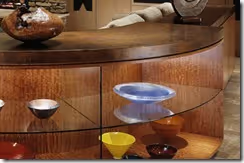
As we embrace the shorter days of fall and winter, light becomes even more important in our spaces. Taking advantage of natural daylight is essential, but with fewer hours available, we must utilize indoor lighting to a greater extent.

Lighting can make a big difference in your home- creating a mood, making tasks easier, and providing safety and security. Good lighting can help to add a sense of drama and beauty to a room, or even simply a feeling of comfort. It can set the mood- stimulating excitement for entertaining, or soothing and calming for relaxing.
Lighting fixtures can also be used as decorative elements in a space – adding sparkle and style, they are the ideal accessory to complete your home. There are nearly unlimited options available in shapes, sizes, colors and styles to complement any décor.
Lighting makes a difference in so many ways, and it is an inexpensive way to update a room dramatically and quickly. Whether you are remodeling or redecorating, lighting gives you flexibility in adapting the mood and ambience of your home to your needs.
When you are planning your lighting to complement your lifestyle, it is best to develop a home lighting plan that meets your individual needs. To achieve a comprehensive and successful solution, keep these tips in mind.
there are three basic types of lighting used in your home that work together to create the overall lighting plan:
Ambient lighting provides an area with overall illumination and light. It also sometimes called general lighting, and gives a comfortable level of light without glare that allows you to see and move about safely.
Ceiling or wall fixtures, chandeliers, recessed or track lights and outdoor lanterns all create ambient lighting. A good lighting plan will include a central source of general light in each room.



Task lighting is focused on a specific area and helps you to perform certain tasks such as reading, doing homework, cooking, playing games, or grooming. It can be provided by track lighting, recessed cans, under-cabinet lighting, and table lamps. Task lighting should be bright enough to prevent eyestrain, but not so bright as to create glare.


Accent lighting is used to add drama and visual interest to a room. In an interior space, it is used to focus on paintings, sculptures, houseplants or other areas of interest. It is often used to highlight texture of stone or brick. It is usually provided by track fixtures or recessed art lights.
Coming in Part 2, we will discuss the different types of fixtures and how they can be used to create specific moods in a home or space. In Part 3, we will examine how lighting can become more energy efficient and the latest types of energy-saving fixtures available. Stay tuned!
Schedule your Discovery Call today to explore how we can bring your WELL Designed™ home to life.